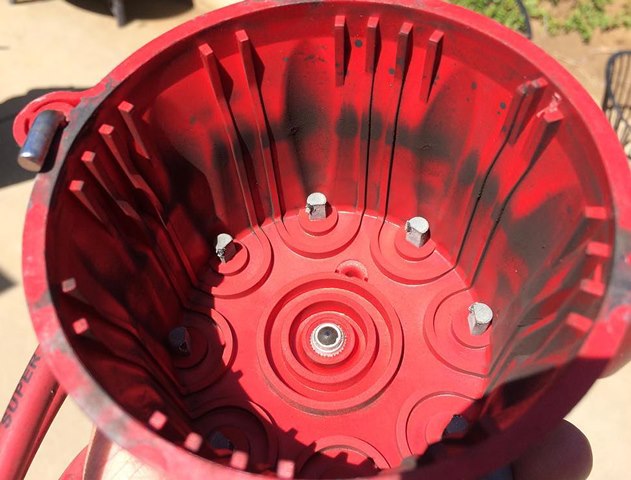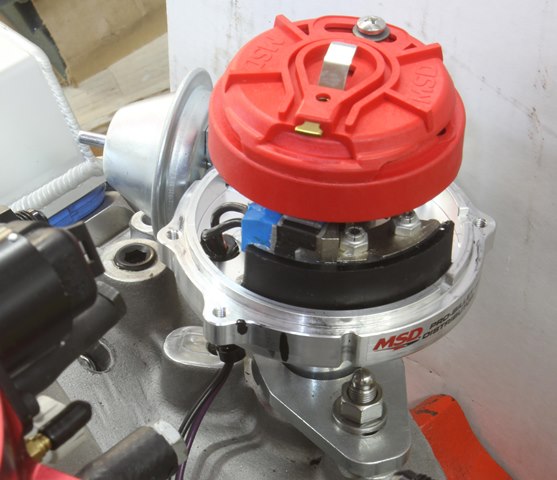How To Clean Msd Distributor Cap Contacts
I was working on my engine the other day when I pulled the distributor cap and noticed what looked similar grease effectually the inside of the cap. Only what really caught my eye was the strange buildup of crud on one end of each spark plug wire terminal on the cap. What causes this and how practise I forestall information technology?
West.D.

This is the photograph of the cap that West.D sent us with his question. Notice the dark iron oxide area on the inside of the cap. Our guess is that the within of his rotor was absolutely filled with this stuff. Also notice the whitish aluminum oxide deposits on the spark plug wire terminals. That's not good. (Image/Jeff Smith)
Jeff Smith: At kickoff glance, I thought the dark area on the cap was grease. But looking more than closely, I've seen a nighttime brownish material coating similar this before, actualization similar a very fine powder. Most often, I see this on the inside of HEI distributors, but information technology can be common on whatever distributor. This material is atomic number 26 oxide and is the result of misfires within the cap from errant sparks inside the cap looking for a convenient ground path.
Electricity will ever follow the path of to the lowest degree resistance. If the rotor gap is too large, often the resistance from this large gap volition exist greater than the resistance created to leap down to the steel rotor screws and into the mechanical advance weights in the distributor. When this happens regularly, the electric energy oxidizes the metal in the mechanical advance, turning some of the iron into iron oxide particles that collect on the inside of the cap when thrown off from the rotor.
So we demand to discover why this is occurring.
Our first inkling is to look closely at the spark plug terminals on the inside of the cap. Notice that they are not brass. These terminals are aluminum. This is an indication of an inexpensive distributor cap. Aluminum does not behave electricity well-nigh as efficiently as brass or copper. This means at that place will be more than resistance in the high tension circuit to the spark plugs. You may not realize it, but aluminum does corrode. It only doesn't rust like iron components. Merely this corrosion shows upward every bit aluminum oxide. I believe that's what we see equally buildup on the edge of each terminal. This corrosion creates resistance, which reduces the voltage that ends upwardly reaching the spark plug. So if your plug wires as well have high resistance, this actually tin hurt spark energy. If you lose enough spark free energy, part-throttle power will suffer and the engine will seem sluggish and unresponsive to throttle.
But what'due south also interesting is the fact that this corrosion is located on the leading edge of the terminal. This is a clue that the rotor is in the wrong position when the pickup aligns with the spinning pole piece and triggers the curl to fire. This is most commonly referred to as rotor phasing. MSD has a good video on what happens when the rotor is not phased properly.
In this case, the rotor is retarded in relation to the pickup. So when the pickup triggers the coil to fire, the rotor has not yet avant-garde enough to line up with the terminal on the cap. The deposits on your cap betoken that the rotor consistently fires short of the spark plug terminal. This requires the spark to spring the large gap between the rotor and the cap. If the rotor is retarded enough, it might actually drain voltage off to the previous cylinder. You won't necessarily feel this as a defended misfire because that voltage ends up in a cylinder that is on the frazzle stroke. And so the plug might fire, but it volition be doing so into essentially a expressionless cylinder. The real issue is that some voltage is beingness siphoned off to the previous cylinder in the firing order.
The prepare for this malady is to first ensure the mechanical advance machinery is fully functional. Remove the rotor and lightly lube the mechanical accelerate mechanism to ensure it works properly. Next, brand certain that the MSD cap is properly registered with the distributor cap pin in the slot in the benefactor. Information technology's possible that the cap was improperly registered on the benefactor. Also make certain that the cap you lot are using is a true MSD benefactor cap with contumely terminals and not aluminum.
Now mount the rotor on the distributor and bump the engine effectually until the balancer displays roughly fifteen degrees before top expressionless center (BTDC). This doesn't accept to exist exact. At present place the cap on the distributor and carefully place a Sharpie mark on the distributor body that vertically lines upwards with the Number One spark plug wire last on the cap. Twist the rotor to maximum advance and make some other, smaller marking on the distributor body. At present remove the distributor cap and evaluate how close the rotor terminal is to line up with either the large or pocket-size marks on the distributor. If the rotor is positioned between the 2 marks, then the rotor phasing is acceptable. The rotor should be adequately close to the marking on the distributor. If the rotor is pointed away from both marks, then you lot will probably have to purchase an adjustable rotor from MSD (PN 8421) to correct the problem.

This is an adaptable rotor fitted to an MSD distributor. Note that nosotros've positioned the rotor just before the black line on the distributor torso. When the mechanical advance moves the rotor (roughly 21 degrees or xv initial + 21 mechanical = 36 degrees BTDC), information technology will swing from before the terminal to afterwards, which volition exist as close as we tin can go throughout the entire advance curve. (Image/Jeff Smith)
This adjustable rotor allows the tuner to move the tip relative to its stock location to line upwards the rotor with the last on the cap. We chose 15 degrees because that'south a typical initial timing setting. Equally the mechanical advance operates, it moves the rotor ahead to advance the timing. We set upward 1 of our test small blocks and discovered that our distributor advanced the timing and moved the rotor abroad from the static location, creating more distance between the rotor and the cap final. An adaptable rotor immune the states to movement the rotor and so that information technology remained close to the spark plug last.
MSD's You Tube video illustrates this dynamically with a timing light and a hole drilled into the top of the distributor cap. Yous tin also do this if that's easier. Our above description is the way to set up a brand new engine and benefactor so that it's all set to go. Promise this helps.
How To Clean Msd Distributor Cap Contacts,
Source: https://www.onallcylinders.com/2016/07/22/what-causes-distributor-cap-corrosion-and-deposits-and-how-can-you-avoid-them/
Posted by: millerponsin.blogspot.com


0 Response to "How To Clean Msd Distributor Cap Contacts"
Post a Comment